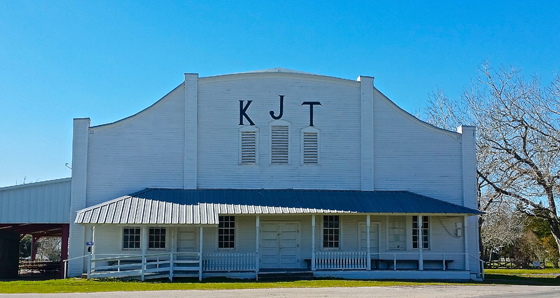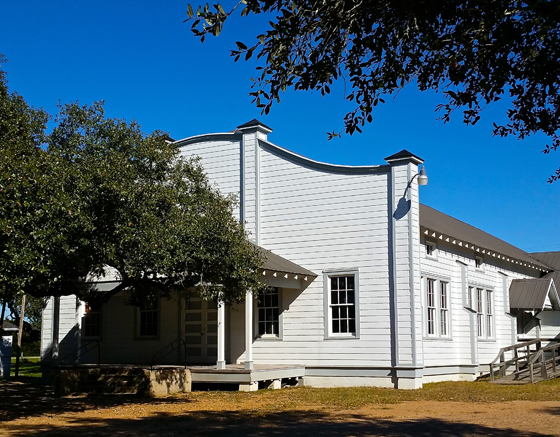A Look at Ammannsville and Dubina

2024 Spring Antiques Show | March 14 – 31
2024 Fall Antiques Show | October 10 – 27

Years after my first dance hall visit, I decided to write about the vibrant settings that had become a regular part of my life. I wanted to share the halls not through my eyes alone but also through the eyes of individuals I met at each gig who keep dance hall culture strong—hall owners, musicians, patrons and friends. Gail Folkins
Ammannsville and Dubina Halls
Riding in a tan van through Fayette County, I breathe in fields of blowing grasses as the narrow road we follow parts them like a comb. Gary McKee, a Schulenburg native and vice chair of the Fayette County Historical Commission, has volunteered to give me an early afternoon tour of some of the many dance halls in this part of East Central Texas. On this warm day in March, Gary plots a course to the Fayette County communities of Ammannsville and Dubina. The sun straight overhead pierces through the oak leaves and into the van.

Off a gravel road south of La Grange, Gary’s expression brightens. He adjusts his baseball cap and scans the roadway for a shady place to park. Ammannsville, our dance hall destination, stands at a corner created by three intersecting roads—the asphalt version we drive on, a dusty road that meets it from a grove of trees and a second dirt road that I later learn leads back to Schulenburg. From the shady parking spot Gary has found, we climb out of the van.
Above us towers a well preserved dance hall painted white with a hint of yellow. I look up to read the tall, black letters on its front—K.J.T.—which stand for Katolika Jednota Texaska (Catholic Union of Texas). Ammannsville served as one of four original lodges within the K.J.T., a fraternal Czech-Catholic organization formed in 1889. Fayette County records state that Ammannsville, Dubina and Hostyn were the first Czech settlements in Texas, and about 75 percent of Czech immigrants were Roman Catholics. A nearby church, painted an even brighter shade of white, points its steeple towards the clouds.
The only car that sits in the gravel parking lot belongs to a nearby group preparing for a picnic. Ammannsville and other local communities host church picnics, family reunions and saint’s days celebrations in their halls.
“We’ve had parties here until two in the morning,” Gary chuckles. A person can celebrate an entire lifetime in a dance hall, he adds, from baptism to birthday parties to wedding and funeral receptions.

We spend a half-hour in the hall before driving down the road to Dubina Hall, which appears in a sudden cluster of buildings behind an old oak grove.
Established in 1856, Dubina was one of the largest all-Czech settlements in Texas. The first immigrants endured a sleet storm to settle the area in late November 1856. The community survived its first winter and planted for spring, but the resulting crop was only one bale of cotton.
Although smaller than Ammannsville, the Dubina dance hall looks no less grand with its wooden floors illuminated in the afternoon light. About 20 townspeople mingle around plates of barbecue for a Sunday picnic. They invite us to join them, but still full from lunch earlier that day, we politely decline.
With so many dance halls scattered throughout the area, Saturday night dances could be found almost anywhere in Fayette County during the first half of the 20th century.
“The Czech musicians played the accordion and made their own beer,” says Fayette County Judge Ed Janecka who meets us on the church steps.
“It was a place for people to get together,” he says of the dance hall in Dubina. “I have wonderful memories of growing up here with the polka and folk dances along with some rock dances.”
Today, the rural location of the dance halls impacts the performances they host.
“People don’t live as close to the halls as they once did,” Ed says. “It used to be there were halls everywhere, some in the middle of nowhere. The 1930s were the golden age of Czech polka music.”
After World War II, many of the polka bands broke up, and the growing popularity of country and rock music soon changed the flavor of the music played within the halls.
“We give polka and waltz lessons at the hall,” Ed says. Along with providing a social outlet, such efforts also keep traditional dances alive.
Gary’s eyes light up at this news; I watch him make a mental note about the next sessions.
“My favorite thing,” Ed says, “is when the dancers all move together as one.”
I cannot tell if he is talking about past or present and decide he probably means both.
[line]
by Gail Folkins

Originally from Issaquah, Washington, Gail Folkins has worked as a journalist, a freelance writer/editor and a writing instructor. She began teaching after receiving a master’s degree in English at Texas State University and completed her Ph.D. in English from Texas Tech University in 2006. The Center for Texas Music History at Texas State University in San Marcos graciously granted permission to reprint excerpts from the original article, “Texas Dance Halls: History, Culture and Community” that appeared in the Journal of Texas Music History (Vol. 6) in 2006.
2024 Spring Antiques Show | March 14 – 31
2024 Fall Antiques Show | October 10 – 27